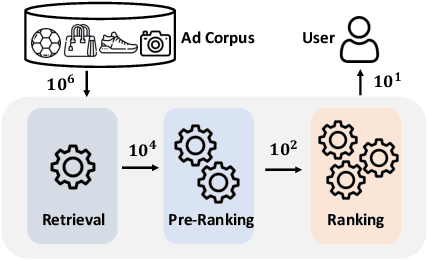Zhishan Zhao
COPR: Consistency-Oriented Pre-Ranking for Online Advertising
Jun 06, 2023



Abstract:Cascading architecture has been widely adopted in large-scale advertising systems to balance efficiency and effectiveness. In this architecture, the pre-ranking model is expected to be a lightweight approximation of the ranking model, which handles more candidates with strict latency requirements. Due to the gap in model capacity, the pre-ranking and ranking models usually generate inconsistent ranked results, thus hurting the overall system effectiveness. The paradigm of score alignment is proposed to regularize their raw scores to be consistent. However, it suffers from inevitable alignment errors and error amplification by bids when applied in online advertising. To this end, we introduce a consistency-oriented pre-ranking framework for online advertising, which employs a chunk-based sampling module and a plug-and-play rank alignment module to explicitly optimize consistency of ECPM-ranked results. A $\Delta NDCG$-based weighting mechanism is adopted to better distinguish the importance of inter-chunk samples in optimization. Both online and offline experiments have validated the superiority of our framework. When deployed in Taobao display advertising system, it achieves an improvement of up to +12.3\% CTR and +5.6\% RPM.
FINT: Field-aware INTeraction Neural Network For CTR Prediction
Jul 30, 2021



Abstract:As a critical component for online advertising and marking, click-through rate (CTR) prediction has draw lots of attentions from both industry and academia field. Recently, the deep learning has become the mainstream methodological choice for CTR. Despite of sustainable efforts have been made, existing approaches still pose several challenges. On the one hand, high-order interaction between the features is under-explored. On the other hand, high-order interactions may neglect the semantic information from the low-order fields. In this paper, we proposed a novel prediction method, named FINT, that employs the Field-aware INTeraction layer which captures high-order feature interactions while retaining the low-order field information. To empirically investigate the effectiveness and robustness of the FINT, we perform extensive experiments on the three realistic databases: KDD2012, Criteo and Avazu. The obtained results demonstrate that the FINT can significantly improve the performance compared to the existing methods, without increasing the amount of computation required. Moreover, the proposed method brought about 2.72\% increase to the advertising revenue of a big online video app through A/B testing. To better promote the research in CTR field, we released our code as well as reference implementation at: https://github.com/zhishan01/FINT.
 Add to Chrome
Add to Chrome Add to Firefox
Add to Firefox Add to Edge
Add to Edge